Vertical gardens transform walls and railings into thriving pollinator habitats, packing over 30 plants per square foot. You’ll create safer foraging zones that protect bees and butterflies from ground-level hazards like pesticides and predators. These elevated gardens increase visitation rates while mitigating urban heat effects and enhancing your property’s aesthetics. Native climbing plants provide continuous nectar sources throughout the growing season. Discover how your vertical space can become a biodiversity hotspot with minimal effort and maximum impact.
10 Second-Level Headings for “Why Choose Vertical Gardens For Pollinators?”
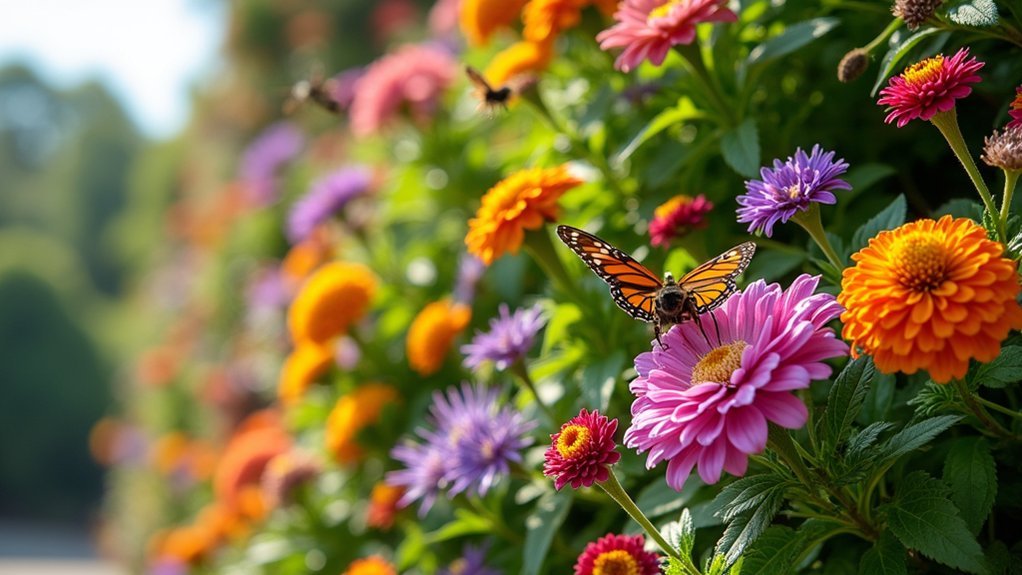
Each section should explore specific advantages of vertical gardens. For example, under “Height Advantage,” you’ll learn how elevated plantings reduce disturbances from pedestrians while attracting more pollinators.
The “Space Optimization” section can explain how vertical systems maximize limited urban areas compared to traditional beds.
Don’t forget to include “Microclimate Benefits,” where you can highlight how vertical gardens help mitigate urban heat islands, creating cooler environments that pollinators prefer during hot seasons.
These organized sections will guide your understanding of vertical garden benefits.
The Space-Saving Advantage of Vertical Pollinator Gardens
Urban gardeners, apartment dwellers, and homeowners with limited outdoor space face a common challenge: how to support pollinators when square footage is at a premium.
Vertical gardens offer an elegant solution, packing over 30 plants into just one square foot—transforming your walls, balconies, and terraces into thriving pollinator habitats.
Transform vertical space into pollinator paradise—30+ plants per square foot brings biodiversity to even the smallest urban settings.
Consider these space-optimizing benefits:
- Density multiplication – Your vertical garden can support 30+ plants per square foot, dramatically increasing nectar sources compared to traditional beds.
- Height advantage – Elevated plantings actually increase pollinator visitation rates while keeping them safe from foot traffic.
- Underutilized surface conversion – Transform bare walls and railings into biodiversity hotspots where ground space simply doesn’t exist.
Native Climbing Plants That Attract Local Pollinators
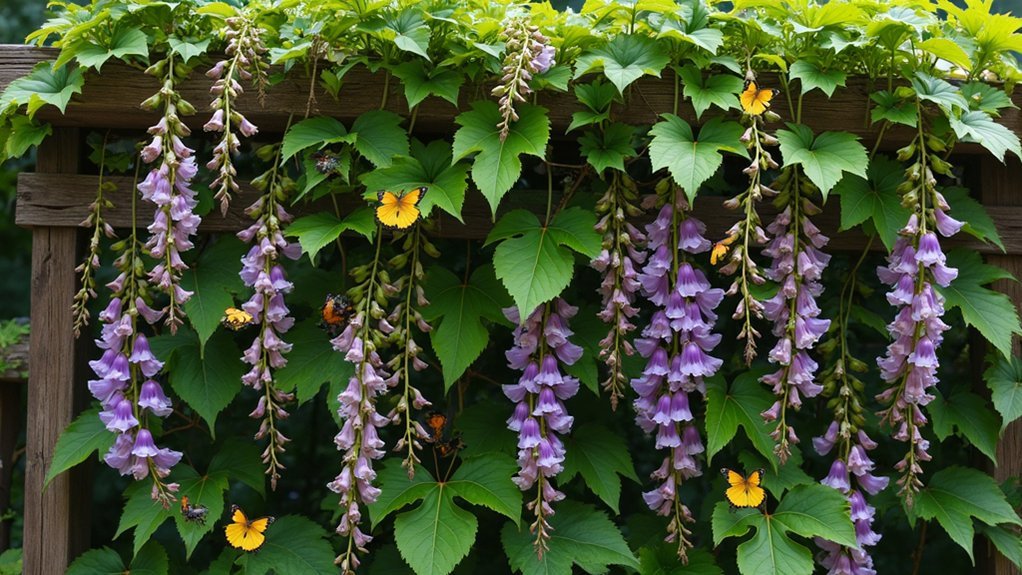
Four exceptional native climbing plants can transform your vertical garden into a pollinator paradise while conserving precious space. Virginia creeper provides essential nectar throughout the growing season, supporting diverse local pollinators. Honeysuckle attracts hummingbirds and bumblebees with its fragrant, nectar-rich blooms.
| Plant | Key Pollinators | Bloom Time |
|---|---|---|
| Virginia Creeper | Bees, Butterflies | All Season |
| Honeysuckle | Hummingbirds, Bumblebees | Spring-Summer |
| Passionflower | Gulf Fritillary Larvae | Summer |
| Clematis | Late-Season Pollinators | Late Summer-Fall |
Consider passionflower for its beautiful symbiotic relationship with butterfly larvae, while native clematis offers critical late-season support when other pollinator plants have finished blooming. By incorporating these climbing species, you’ll create multi-layered habitats that enhance foraging opportunities for diverse pollinators.
Creating Multi-Season Blooms on Vertical Structures
To maintain a thriving vertical pollinator garden throughout the year, you’ll need a staggered flowering plan that incorporates spring bulbs, summer perennials, and fall-blooming vines.
Choose drought-resistant plants like sedum and yarrow that will continue flowering even during dry periods, ensuring continuous nectar sources without excessive watering.
Your four-season design should include evergreen structural elements, early-spring bloomers, summer flowering climbers, and late-season plants with seedheads that provide winter interest and food for birds.
Staggered Flowering Plans
When designing a vertical garden for pollinators, staggered flowering plans become essential for maintaining consistent nectar sources throughout the growing season.
You’ll create a year-round haven for bees, butterflies, and other beneficial insects by selecting pollinator-friendly plants that bloom at different times.
Native wildflowers are particularly effective in your vertical setup as they’ve adapted to local climate conditions and attract regional pollinators.
With limited urban space, your vertical garden maximizes ecological impact by providing continuous blooming cycles.
- Select early spring bloomers (crocus, snowdrops) to support pollinators emerging from winter
- Add summer-flowering varieties (lavender, echinacea) for peak season support
- Include late-season plants (asters, goldenrod) to provide critical pre-winter nutrition
This strategic approach guarantees your vertical garden remains a bustling pollinator hub regardless of the season.
Drought-Resistant Plant Selection
Selecting drought-resistant plants becomes essential for vertical pollinator gardens, especially in regions facing water restrictions or during hot summer months.
You’ll find succulents and native wildflowers thrive in these systems while reliably providing nectar for pollinators when water is scarce.
Plants like Lavender and Sedum work perfectly in vertical structures, offering multi-season blooms that guarantee continuous food sources for bees and butterflies year-round.
Their deep root systems help stabilize your vertical garden while requiring minimal irrigation—ideal for urban settings with limited water access.
Four-Season Design Strategies
Since pollinators require food sources year-round, designing vertical gardens with continuous blooms becomes crucial for supporting these essential creatures through every season.
Your pollinator garden can thrive vertically while providing year-round benefits when you employ strategic planting techniques.
- Diversify bloom times – Incorporate wildflowers that flower sequentially throughout spring, summer, fall, and even winter in milder climates to guarantee continuous nectar sources.
- Create layered plantings – Position taller plants to shade lower-growing species, extending bloom periods and creating microhabitats that protect pollinators during weather fluctuations.
- Utilize native perennials – Plants like coneflowers and bee balm on trellises not only attract diverse pollinators but also thrive in local conditions, requiring less maintenance while providing reliable seasonal blooms.
Designing Living Fences for Maximum Pollinator Appeal
Living fences transform ordinary boundaries into vibrant, three-dimensional pollinator habitats that serve dual purposes: defining your space while supporting local biodiversity. When you incorporate native flowering plants into vertical structures, you’re creating essential foraging zones that attract and sustain pollinators throughout the seasons.
| Plant Selection | Pollinator Benefit |
|---|---|
| Native wildflowers | Provide familiar nectar sources |
| Black-eyed Susans | Attract diverse bee species |
| Coneflowers | Support butterflies and moths |
| Seasonal bloomers | guarantee year-round resources |
| Vertical pockets | Maximize space for more diversity |
Your living fence’s height naturally reduces human interference, creating quieter environments where pollinators can work undisturbed. By utilizing trellises and wall-mounted systems, you’ll optimize limited space while providing the vertical foraging zones that research shows wild bees particularly prefer in urban settings.
How Vertical Gardens Protect Pollinators From Urban Hazards
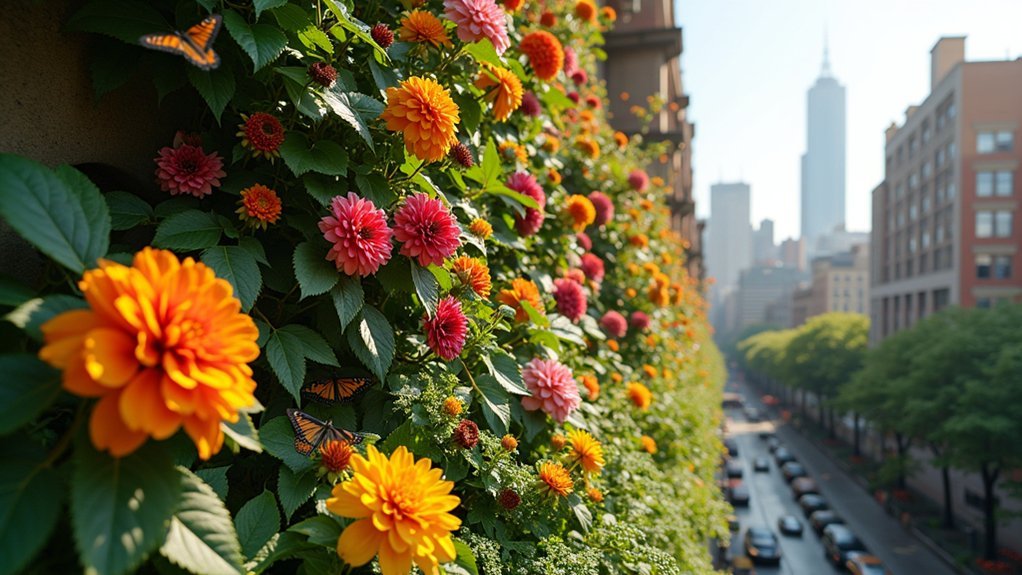
Vertical gardens offer your pollinators life-saving protection from several common urban threats.
The elevated position shields bees and butterflies from traffic collisions while considerably reducing their exposure to ground-level pesticides applied to lawns and conventional landscaping.
You’ll also provide vulnerable pollinators with sanctuary from prowling cats, which annually kill millions of beneficial insects during their hunting adventures.
Height Prevents Traffic Collisions
While urban environments pose numerous threats to pollinator populations, elevated vertical gardens offer a surprisingly effective safety solution.
When you install vertical gardens at height, you’re creating natural barriers that prevent dangerous collisions between pollinators and the busy world below.
Research confirms that pollinators actually prefer these elevated spaces:
- Higher vertical plantings greatly reduce the risk of pollinators colliding with pedestrians and vehicles.
- Pollinator visits increase as the height of vertical systems rises, showing their preference for elevation.
- Elevated gardens minimize exposure to ground-level hazards like pesticides and litter.
Reduced Pesticide Exposure
Beyond height protection, vertical gardens create chemical sanctuaries for vulnerable pollinators in our increasingly toxic urban landscapes. Your vertical setup elevates plants away from ground-level pesticide applications, considerably reducing harmful chemical exposure to bees, butterflies, and other essential pollinators.
| Benefit | Vertical Garden | Traditional Garden |
|---|---|---|
| Soil Contact | Minimal exposure | Direct contact with treated soil |
| Runoff Exposure | Elevated above contamination | Receives chemical runoff |
| Foot Traffic | Protected structure | Regular disruption |
| Biodiversity | Creates safe refuge | More vulnerable to treatments |
Research shows pollinator populations thrive better in vertical systems, with higher visitation rates and healthier foraging behaviors. By creating this physical separation from urban pesticides, you’re not just growing plants—you’re establishing vital safe havens where pollinators can feed without ingesting harmful chemicals that compromise their health and survival.
Cat Predation Protection
Urban cats pose a significant threat to pollinators, stalking and hunting vulnerable insects as they forage for nectar at ground level.
Vertical gardens offer a strategic solution to this urban hazard by elevating flowering plants beyond a cat’s hunting zone.
Your vertical gardens create safer foraging spaces through:
- Height advantage – Plants growing several feet above ground remain out of reach for prowling cats.
- Structural barriers – Trellises and vertical frameworks naturally deter predators while supporting plant growth.
- Reduced disturbance – Minimized foot traffic around vertical gardens means pollinators can feed with fewer interruptions.
Research confirms that these elevated sanctuaries increase wild bee visitation rates compared to ground-level plantings.
Building Materials and Support Systems for Pollinator Walls
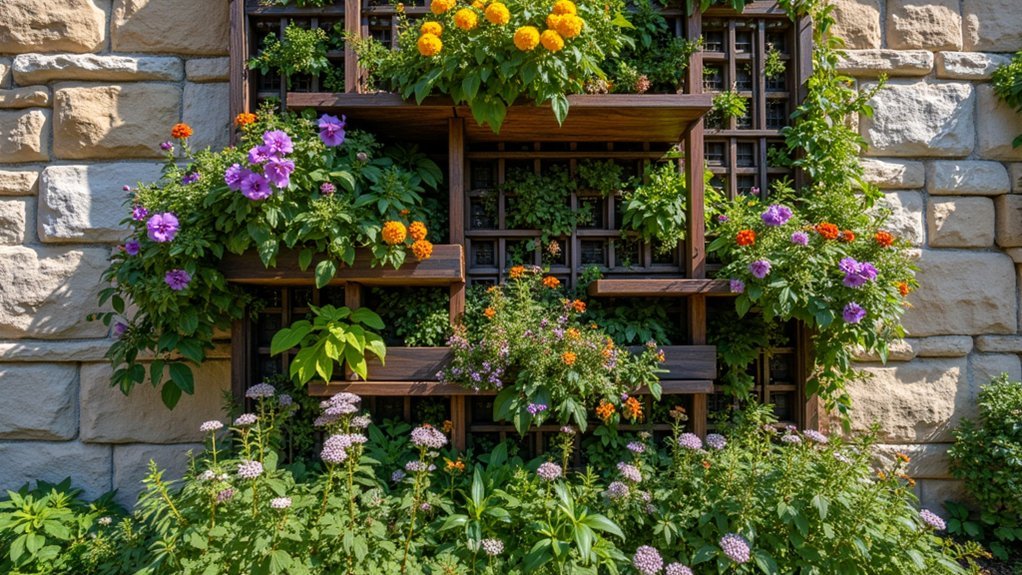
As you plan your vertical pollinator garden, selecting the right materials and support systems forms the foundation of your project’s success. Wood, metal, and recycled plastic offer sustainable options that create lasting pollinator habitats while reflecting your personal style.
You’ll need reliable support structures to maximize your vertical space. Trellises provide excellent climbing surfaces for vining plants, while wall-mounted pockets create discrete planting areas throughout your design.
When selecting soil, opt for lightweight mixtures that won’t overburden your structure while providing proper drainage and moisture retention.
Consider installing modular planting systems that make maintenance and plant replacement straightforward. This flexibility allows you to adjust your garden as you observe which plants attract the most pollinators.
Complete your design with a water-efficient drip irrigation system to keep plants thriving with minimal waste.
Combining Aesthetics and Ecological Benefits in Boundary Plantings
You’ll create more than just a boundary when you transform fences and walls into vibrant pollinator habitats that serve as living ecosystems.
Your vertical garden can simultaneously enhance property aesthetics while providing critical resources for bees, butterflies, and other beneficial insects throughout the seasons.
These dual-purpose living walls maximize limited urban space, turning ordinary boundaries into conversation pieces that demonstrate environmental stewardship while maintaining privacy and defining your landscape.
Habitat on Boundaries
While traditional gardens expand horizontally, vertical gardens transform property boundaries into thriving pollinator ecosystems without sacrificing precious space. Your boundary walls become essential habitats where wild bees and other pollinators can thrive, particularly in urban environments where green space is limited.
These vertical systems offer several advantages:
- Increased foraging efficiency – Elevated plantings reduce human interference, allowing pollinators easier access to nectar sources.
- Climate regulation – Vertical gardens help mitigate urban heat island effects, creating cooler microclimates that pollinators prefer.
- Enhanced biodiversity – A variety of flowering plants on your vertical walls attracts diverse pollinators, strengthening local ecosystem health.
You’ll maximize your property’s ecological contribution while maintaining aesthetic appeal, turning otherwise unused vertical surfaces into productive pollinator-supporting landscapes.
Dual-Purpose Living Walls
Living walls offer a perfect fusion of artistry and ecology, transforming ordinary boundaries into vibrant ecosystems that delight both human and pollinator visitors.
These vertical gardens maximize your space efficiency, housing over 30 plants per square foot while creating essential habitat for native pollinators in urban areas where ground planting options are limited.
Research shows wild bees actually prefer these vertical structures to horizontal plantings, making living walls particularly effective for supporting urban pollinator populations.
You’ll also enjoy practical benefits beyond biodiversity—these installations help combat the urban heat island effect by creating shaded areas that can be 20-45°F cooler than surrounding surfaces.
Water Management Strategies for Vertical Pollinator Habitats
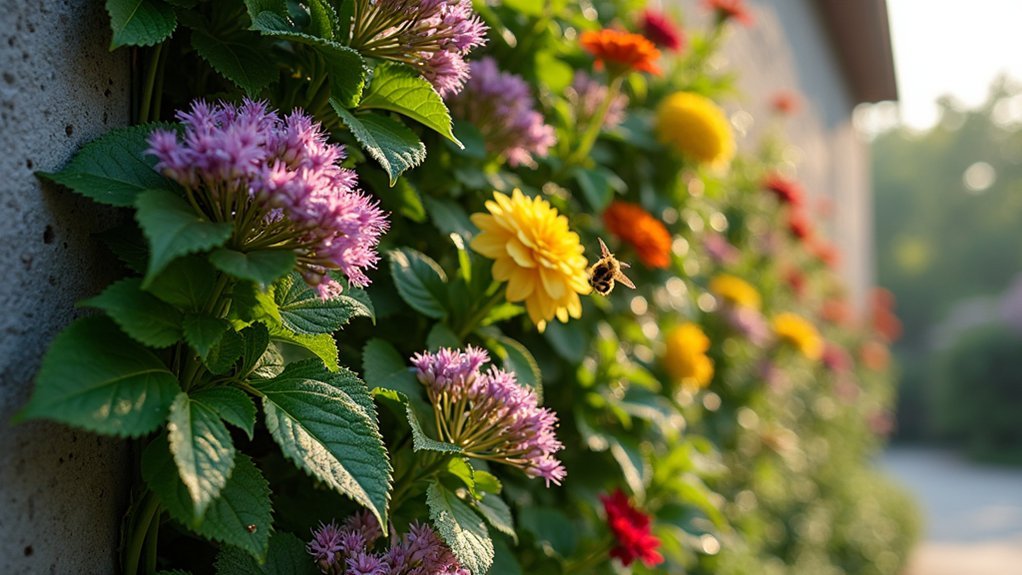
Successful vertical pollinator gardens depend on thoughtful water management systems that balance moisture needs without creating excess runoff.
Your vertical garden’s elevated position accelerates evaporation, requiring tailored water management strategies to maintain ideal pollinator habitat conditions.
Implement these efficient watering solutions:
- Install drip irrigation systems that deliver water directly to plant roots, minimizing waste while ensuring your pollinator-friendly plants receive consistent moisture.
- Incorporate water-retaining amendments like coconut coir or hydrogel crystals to stabilize moisture levels and reduce watering frequency.
- Harvest rainwater using barrels or green roof systems to create a sustainable water source while adding built-in reservoirs for regulated moisture delivery.
Regular moisture monitoring is essential, as vertical structures dry out faster than ground-level gardens, affecting both plant health and pollinator activity.
Measuring the Impact of Vertical Gardens on Local Pollinator Diversity
Beyond designing and maintaining your vertical garden lies an important question: how effectively does it support local pollinators?
Research provides compelling evidence of their significant impact. A German study documenting nearly 13,000 pollinator visits revealed that vertical systems attract different species than traditional horizontal plantings.
You’ll find wild bees particularly favor vertical gardens, while honey bees prefer horizontal beds. Notably, visitation rates increase with height as these elevated gardens reduce human interference from foot traffic.
Frequently Asked Questions
What Are the Benefits of Vertical Gardening?
Vertical gardens maximize your space, supporting 30+ plants per square foot. You’ll enjoy enhanced biodiversity, cooler temperatures (up to 45°F lower), and increased pollinator activity as higher plantings reduce human interference.
What Is the Best Landscaping for Pollinators?
The best landscaping for pollinators includes native wildflowers like Black-eyed Susans and Milkweed. You’ll want to create diverse plantings at various heights, guarantee continuous blooming throughout seasons, and position your garden in sunny locations.
Why Might Growers Choose to Plant a Vertical Garden?
You’ll choose vertical gardens to maximize limited urban space, attract wild bees, enhance biodiversity, reduce foot traffic interference, and increase pollinator habitat. They’re perfect when you can’t expand horizontally but want to support pollinators effectively.
What Are the Disadvantages of Vertical Gardens?
You’ll face higher installation costs, more frequent watering, limited root space for plants, increased exposure to harsh weather, and challenging accessibility for maintenance. Vertical gardens also make pollinator access and harvesting more difficult.
What Makes a Good Pollinator Garden?
A good pollinator garden includes diverse native wildflowers, sunny locations, and pesticide-free maintenance. You’ll attract more pollinators if you plant at various heights and provide shelter from wind for ideal foraging conditions.
In Summary
You’ll find vertical gardens aren’t just space-efficient and beautiful—they’re pollinator lifelines. By creating these living walls with native climbers and multi-season blooms, you’re building vital habitats in areas where traditional gardens can’t exist. Your vertical pollinator paradise will contribute meaningfully to local biodiversity while transforming fences and walls into ecological assets. It’s a win for you, your neighborhood, and our vital pollinator friends.

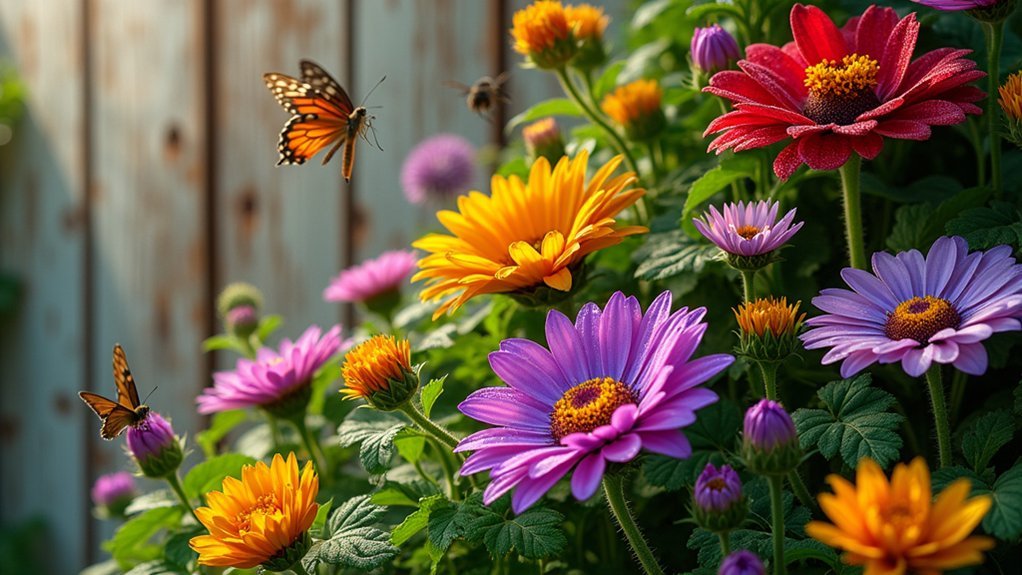



Leave a Reply